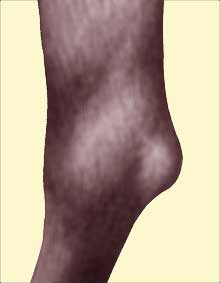Equine Capped Hocks - Causes, Treatment in Horses
WHAT IS A CAPPED HOCK?
 A
capped hock, also known as hygromas,
refers to the presence of a floppy ball-like
swelling which forms over the point of the horse's hock due
to the accumulation of excessive inflammatory fluid in a membrane lined
cavity called a bursa.
A
capped hock, also known as hygromas,
refers to the presence of a floppy ball-like
swelling which forms over the point of the horse's hock due
to the accumulation of excessive inflammatory fluid in a membrane lined
cavity called a bursa.
This bursa is present in the tissues between the flexor tendon and the skin as the tendon runs over the point of the horse or pony's hock.
The wall of the bursa may thicken with the formation of fibrous tissue due to the low-grade inflammatory reaction present - this thickened swelling is what is known as a capped hock.
CAUSES OF CAPPED HOCKS IN A HORSE OR PONY
Capped hocks occur most often when a horse or pony
bangs its hocks against a stable or stall wall, or whilst travelling in
a horsebox or trailer.
Capped hocks can also be caused by an injury such as
a kick to the horse's hock.
HOW DOES A CAPPED HOCK AFFECT A HORSE'S PERFORMANCE?
When these equine swellings first appear they can be hot and tender and the horse or pony may show lameness.
With time, the capped hocks cool and invariably remain cold and painless and do not interfere with the function of the horse's hock joint.
Horses are rarely permanently lame as a result of the swelling. Neither does the swelling represent any appreciable weakness in the hock joint.
A capped hock can also result from an injury to a horse, such as being kicked in the hock, so they're not entirely preventable.
Most of the time, once healing of the capped hock is complete they are a cosmetic flaw, not a soundness issue.
PREVENTION OF CAPPED HOCKS IN HORSE
Deep banks of bedding in the horse's stable or stall can help to prevent your horse banging his hocks against the wall.
Use hock boots, or travelling boots whenever you transport your horse.
TREATMENT OF A HORSE OR PONY WITH CAPPED HOCKS
The first thing to do is to eliminate the cause of the trauma - build up the banks of the horse's bed and move to another stable if he is kicking at walls due to being upset by a neighbouring horse.
Cold hydrotherapy or cold hosing can help to limit inflammation and reduce the swelling in the early stages.
When the swelling in the capped hock settles down and becomes cold your vet may try to drain the swelling or inject steroids to reduce the swelling in the capped hock.
HORSE CARE ADVICE AND EQUESTRIAN ARTICLES
Treat Mud Fever in Horse | Symptoms of Colic in Horses | Salt for Horses | Horse Arthritis Supplements | Essex Saddlery | Horse Sarcoids | Supplements for Veteran Horses | Benefits of Glucosamine Supplements for Horses | Horse Feed Storage | Acorn Poisoning | Horse and Hound | Horse Worm Egg Counts | Fitting a Lunge Cavesson | Feeding an Overweight Horse |Kent Tack Shops | What causes capped hocks in a horse or pony, How
to recognise and treat swellings in
the hock of a horse or pony